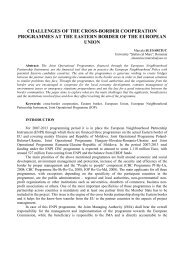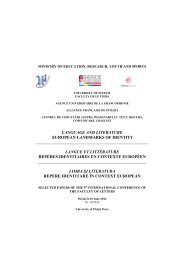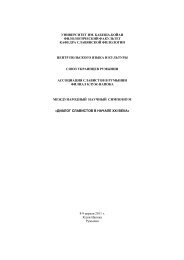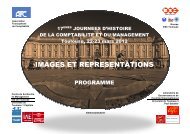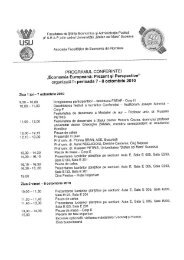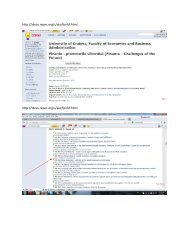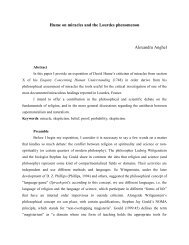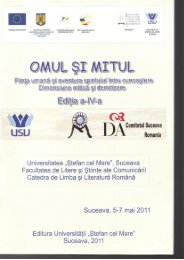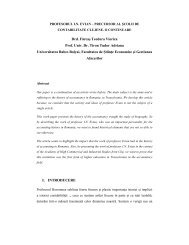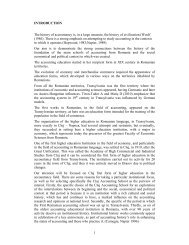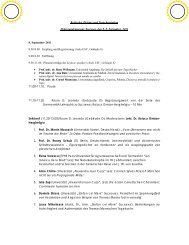Program (RO)
Program (RO)
Program (RO)
You also want an ePaper? Increase the reach of your titles
YUMPU automatically turns print PDFs into web optimized ePapers that Google loves.
Iron Age Rites and Rituals<br />
in the Carpathian Basin<br />
Târgu Mureș, 7–9 October 2011<br />
FRIDAY, 7 October<br />
<strong>Program</strong><br />
15 00 –16 30 Chairman: Tiberius Bader<br />
InauGural sessIon<br />
Tiberius Bader (DE)<br />
Meine Begegnungen mit den Keltenfürsten: am Beispiel<br />
der Fürstengäber von Ciumești und Hochdorf<br />
Jan Bouzek (CZ)<br />
The Earliest la Tène Objects in the Carpathian Basin.<br />
New and Old Evidence<br />
Mircea Babeș–Nicolae Miriţoiu (<strong>RO</strong>)<br />
Verlängerte, mehrstufige birituelle Bestattungen im<br />
Donau–Karpaten-Raum (5. bis 3. Jh. v. Chr.)<br />
Discussions<br />
17 00 –18 30 Chairman: Tiberius Bader<br />
Graves and Grave InvenTorIes<br />
Milica Tapavicki-Ilic–Vojislav Filipović (RS)<br />
[lectured by Marija ljuština]<br />
An interesting late iron Age Grave Find from Syrmia<br />
Marija Ljuština–Miloš Spasić (RS)<br />
Celtic Newcomers between Traditional and Fashionable:<br />
Graves 63 and 67 from Karaburma<br />
Iron Age Rites and Rituals<br />
in the Carpathian Basin<br />
Târgu Mureş, 7–9 October 2011<br />
Aurel Rustoiu–Sándor Berecki (<strong>RO</strong>)<br />
The Warrior Grave from Ocna Sibiului, Transylvania<br />
Discussions<br />
SATuRDAY, 8 October<br />
9 00 –10 30 Chairman: Mircea Babeș<br />
The envIronmenT and sTruCTure<br />
of CemeTerIes 1<br />
Erzsébet Jerem (HU)<br />
late iron Age Cemeteries at the Eastern Alps – with<br />
Special Emphasis on their Settings and Ritual Aspects<br />
Gertrúda Březinová (SK)<br />
The Biritual Cemetery in Šurany-Nitriansky Hrádok,<br />
Zámeček, District of Nové Zámky (Slovakia)<br />
Zoltán Czajlik (HU)<br />
Topographical researches on the iron Age Cemeteries in<br />
Hungary. An Aerial Archaeological Approach<br />
Discussions<br />
2 3
Iron Age Rites and Rituals<br />
in the Carpathian Basin<br />
Târgu Mureș, 7–9 October 2011<br />
11 00 –12 30 Chairman: Erzsébet Jerem<br />
The envIronmenT and sTruCTure<br />
of CemeTerIes 2<br />
Zoltán Pilling–Ferenc ujvári (HU)<br />
late iron Age Settlement and Cemetery in the Vicinity<br />
of Szeged. Some New Data on iron Age Burial Rite on the<br />
Southern Part of the Great Hungarian Plain<br />
Andreea Drăgan (<strong>RO</strong>)<br />
late iron Age Burials in the iron Gates Area<br />
Horea Pop–Zsolt Csók (<strong>RO</strong>)<br />
The Tumular Necropolis from Şimleu Silvaniei,<br />
Transylvania<br />
Discussions<br />
13 00 –14 30 Chairman: Jan Bouzek<br />
ColleCTIve behavIour of soCIal sTruCTures<br />
Maciej Karwowski (Pl)<br />
late iron Age Ritual and Mythical Representations from<br />
Oberleiserberg in lower Austria<br />
Peter Ramsl (AT)<br />
Rites and Rituals in la Tène Age Cemeteries in Eastern<br />
Austria<br />
Iron Age Rites and Rituals<br />
in the Carpathian Basin<br />
Târgu Mureş, 7–9 October 2011<br />
Károly Tankó (HU)<br />
la Tène Period Burial Practices in North-Eastern<br />
Hungary<br />
Discussions<br />
16 00 –17 30 Chairman: Gertrúda Březinová<br />
InvenTorIes, arTefaCTs and analyTIC<br />
approaChes 1<br />
Beatrice Kelemen–Cristian C. Roman–Iosif Vasile<br />
Ferencz–Delia M. Roman–Oana Ponta–Simion<br />
Simion (<strong>RO</strong>)<br />
Additional information on Cremated Remains from<br />
Hunedoara–Grădina castelului–Platou Necropolis as<br />
inferred from Anthropometric and Complementary<br />
Analyses<br />
Wolfgang David (DE)<br />
„Keltische“ Helme im Karpatenbecken und ihre<br />
Analogien in italien und Mitteleuropa<br />
Martin Furman (SK)<br />
interpretative Value of the Annular Jewel Garnitures<br />
for the Study of Early Celtic Population in the Middle<br />
Danube Area<br />
Discussions<br />
4 5
Iron Age Rites and Rituals<br />
in the Carpathian Basin<br />
Târgu Mureș, 7–9 October 2011<br />
18 00 –19 30 Chairman: Florea Gelu<br />
InvenTorIes, arTefaCTs and analyTIC<br />
approaChes 2<br />
Gabriela Brezňanová (SK)<br />
Reflection of the Contacts between Celtic Communities<br />
in Transylvania and South-West Slovakia in the Grave<br />
inventories<br />
Paul Pupeză (<strong>RO</strong>)<br />
The Pottery of local Tradition in the Celtic Graves from<br />
the Carpathian Basin<br />
Marcin Rudnicki (Pl)<br />
Finds of Dacian bracelets, type ‘Şimleu Silvaniei’, north<br />
of the Carpathians and the Sudety and their Context<br />
Discussions<br />
SuNDAY, 9 October<br />
9 00 –10 30 Chairman: Aurel Rustoiu<br />
InvenTorIes, arTefaCTs and analyTIC<br />
approaChes 3<br />
Dragoș Măndescu (<strong>RO</strong>)<br />
Killing the Weaponry. An insight on the Graves with<br />
Destroyed Weapons in late iron Age Transylvania<br />
Iron Age Rites and Rituals<br />
in the Carpathian Basin<br />
Târgu Mureş, 7–9 October 2011<br />
Vlad Vintilă Zirra (<strong>RO</strong>)<br />
An ‘Archaeological Sex’ Approach of the Celtic Burials<br />
from Transylvania<br />
Eugen Iaroslavschi–Gelu Florea (<strong>RO</strong>)<br />
An Ornamented Disc from the End of the Second iron<br />
Age in the National History Museum of Transylvania<br />
Discussions<br />
11 00 –12 30 Chairman: Aurel Rustoiu<br />
InvenTorIes, arTefaCTs and analyTIC<br />
approaChes 4<br />
Mariana Egri (<strong>RO</strong>)<br />
‘A warrior never dies’. The Manipulation of Tradition in<br />
Early Funerary Contexts from Pannonia<br />
Cătălin Popa (UK)<br />
Till Death Do Us Part. A Statistical Approach to<br />
identifying Burial Similarity and Grouping. The Case of<br />
the late la Tène Graves from the Eastern Carpathian<br />
Basin<br />
Răzvan Mateescu–Cristina Bodó (<strong>RO</strong>)<br />
The History of an idea. The Dacian ‘Priests’ between the<br />
Ancient Sources and the Contemporary Archaeology<br />
Discussions<br />
6 7
Abstracts<br />
Iron Age Rites and Rituals<br />
in the Carpathian Basin<br />
Târgu Mureş, 7–9 October 2011<br />
MEINE BEGEGNuNGEN MIT DEN KELTENFüRSTEN:<br />
AM BEISPIEL DER FüRSTENGRäBER VON CIuMEșTI<br />
uND HOCHDORF<br />
Tiberius BADER<br />
Hochdorf/Enz, DE<br />
50 Jahre seit der Entdeckung des Fürstengrabes von Ciumești<br />
Vor 50 Jahren, am 10. August 1961 wurde das keltische<br />
Fürstengrab von Ciumești entdeckt. Nach einigen Tagen nach<br />
der Entdeckung war der Referent am Ort und Stelle. im Jahr<br />
1973 hat er den zweiten Teil des Grabes erworben. Er wird die<br />
neue Kenntnisse über die Entdeckung, Fundumstände, Fundverhältnisse<br />
und inventur des Grabes erörtern. Besprochen<br />
werden auch die Erfahrungen für die Rekonstruktion und<br />
Nachbau des Fürstengrabes, am Beispiel von Hochdorf, vor dreißig<br />
Jahren ausgegraben.<br />
THE EARLIEST LA TèNE OBJECTS IN THE<br />
CARPATHIAN BASIN. NEW AND OLD EVIDENCE<br />
Jan BOuZEK<br />
Prague, CZ<br />
New finds from SW Slovakia seem to confirm that this<br />
area should be included into the vast area where Early Celtic<br />
art was known. The most important Early la Tène center<br />
existed in the fort of Horné Orešany–Slepý vrch, at the eastern<br />
promontory of the little Carpathians. Surface survey with<br />
metal detectors and later also excavation brought to light new<br />
mask fibula, an appliqué with a sphinx and several other objects<br />
9
Iron Age Rites and Rituals<br />
in the Carpathian Basin<br />
Târgu Mureș, 7–9 October 2011<br />
of Early Celtic style. Together with earlier known mask fibula<br />
from Slovenské Pravno and the Stupava plaque the new finds<br />
confirm that a local Early la Tène school existed here. The imitation<br />
of Schnabelkanne handle in the Piestany museum belongs<br />
roughly to the same stylistic area. The existence of this eastern<br />
province of Early la Tène art reminds one of the old idea<br />
of Jacosthal on eastern participation in the formation of Early<br />
la Tène style. As no Early Celtic parallels are known as yet in<br />
Moravia, it might have been a small enclave, like that reported in<br />
the story of Onomaris’ expedition, but even if being a marginal<br />
part of the general Early la Tène area, it shows distinct stylistic<br />
peculiarities not fully conforming with the Early Celtic art more<br />
westwards.<br />
From roughly the same area in western Slovakia and Hungary<br />
several bronze vessels come, first held to be of Etruscan<br />
origin, but later recognized as Magna Grecia (Tarentine?) works<br />
distributed nearly exclusively along the eastern shores of italy.<br />
The existence of these pitchers and of one podinapter seems to<br />
suggest that this area enjoyed also some contacts with Caput<br />
Adriae and italy; it may have been involved in amber trade. As<br />
the light substance is easily transportable by porters, its transport<br />
was not necessarily restricted to the official Amber Route<br />
along the Oder and Morava rivers. The torques found at Gorni<br />
Cibar seems to precede chronologically the Celtic Balkan campaigns<br />
and may be a testimony of a visit of a delegation of the<br />
Celts in the area, like that reported on the meeting of the Celts<br />
with Alexander iii.<br />
Iron Age Rites and Rituals<br />
in the Carpathian Basin<br />
Târgu Mureş, 7–9 October 2011<br />
VERLäNGERTE, MEHRSTuFIGE BIRITuELLE<br />
ESTATTuNGEN IM DONAu-KARPATEN-RAuM<br />
(5. bis 3. Jh. v. Chr.)<br />
Mircea BABEș<br />
București, <strong>RO</strong><br />
Nicolae MIRIţOIu<br />
București, <strong>RO</strong><br />
Die, von den Autoren in den eisenzeitlichen Friedhöfen<br />
von Borosești ( jud. iași) und Poienești ( jud. Vaslui), beide im<br />
Osten Rumäniens, durchgeführten Ausgrabungen brachten<br />
vor Jahren höchstinteressante Erkenntnisse hinsichtlich der<br />
eigenartigen Bestattungsbräuche der norddonauländischen<br />
Geten (Getai) während der Frühphase der jüngeren vorrömischen<br />
Eisenzeit (5.–3. Jh. v. Chr.); sie sind vor allem durch<br />
die alternative bzw. sukzessive Verwendung von Körper- und<br />
Brandbestattung im Rahmen einer verlängerten, mehrstufigen<br />
Behandlung eines und desselben Verstorbenen. Ausgangspunkt<br />
unserer Überlegungen bildete die Entdeckung von zwei Grabanlagen<br />
in Borosești (Gr. i und ii), die die Form und das Ausmaß<br />
von normalen Körpergräbern zeigten, dazu auch typische Grabbeigaben<br />
(Tonware, Perlen, Messer), jedoch keine menschliche<br />
Knochen lieferten. in Borosești und ganz speziell in Poienești<br />
wurden aber auch Brandgräber freigelegt, wo der leichenbrand<br />
und die Grabbeigaben ebenfalls in überdimensionale Gruben<br />
deponiert waren, das heißt in Gruben die für Körperbestattungen<br />
ohne weiteres gepasst hätten. Derartige ungewöhnliche<br />
Funde sind aber, etwa zur gleichen Zeit, in einem viel breiteren<br />
Raum nördlich der Unteren Donau, zwischen dem Dniester<br />
(Nistru, Dnestr) im Osten und der Theiß (Tisa, Tisza) in Westen<br />
verbreitet. Solche Bestattungen sind einwandfrei in den Friedhöfen<br />
von Slobozia-Onești, Stelnica, Zimnicea, Fântânele,<br />
Teliţa, Murighiol, Băiţa und Olteni, in Rumänien, Dănceni<br />
und Pârjolteni in der Republik Moldova, Szentes-Vekerzug<br />
10 11
Iron Age Rites and Rituals<br />
in the Carpathian Basin<br />
Târgu Mureș, 7–9 October 2011<br />
und Tápiószele in Ungarn dokumentiert. Für die überdimensionalen<br />
Brandgrubengrüber hat man recht unterschiedliche<br />
Erklärungen vorgeschlagen, vor allem mit Bezug auf einer vermutlichen<br />
Transition von Körper- zur Brandbestattung. Wir<br />
sind aber der Meinung, daß im Falle der Brandgrubengräber, die<br />
großen Grabgruben haben ursprünglich für die provisorische<br />
Körperbestattung der Verstorbenen gedient; erst nach einiger<br />
Zeit sollte die leiche wieder exhumiert und schließlich auf<br />
Scheiterhaufen eingeäschert. Hinterher war der leichenbrand<br />
entweder zurück in der großen provisorischen Grabgrube oder<br />
in einer gesonderten Grabanlage oder sogar an einem anderen<br />
Ort deponiert. in dieser letzten Eventualität, in den früheren<br />
”provisorischen” Grabgruben sind nur noch Reste der Grabbeigaben<br />
erhalten, aber keine Menschenknochen; gewöhnlich<br />
wurden solche Befunde einfach als ”Kenotaphe” ausgedeutet,<br />
ohne aber daß man dabei eine genauere Analyse unternommen<br />
hat. Gelegentlich zeigen die Bauweise und die verwendeten<br />
Baustoffe (Holz, Stein, lehm), z.B. in Dănceni, Zimnicea oder<br />
Olteni, das bestimmte Grabanlagen über die ganze Dauer<br />
verlängerter Bestattungszeremonien offen bzw. zugänglich<br />
geblieben sind, die am/im Grabe stattfinden sollten. Birituelle,<br />
verlängerte bzw. mehrstufige Bestattungsbräuche sind auch<br />
durch die Ethnographie der modernen und aktuellen Primitiven<br />
dokumentiert worden.<br />
Iron Age Rites and Rituals<br />
in the Carpathian Basin<br />
Târgu Mureş, 7–9 October 2011<br />
AN INTERESTING LATE I<strong>RO</strong>N AGE GRAVE FIND<br />
F<strong>RO</strong>M SYRMIA<br />
Milica TAPAVIčKI-ILIć<br />
Belgrade, RS<br />
Vojislav FILIPOVIć<br />
Belgrade, RS<br />
in 2004, a local amateur-archaeologist – Branko Najhold<br />
– came into the possession of a few objects apparently dating<br />
from the late iron Age. The objects were discovered by a farmer<br />
somewhere in Syrmia, probably close to modern Sremska<br />
Mitrovica. No other information about the circumstances of<br />
discoveries is known. The number and structure of the objects<br />
indicate that these probably belonged to a grave-find. The<br />
inventory includes the following objects: a bronze kettle, a<br />
bronze simpulum, two spears, one of which was bent twice, an<br />
iron knife and four pieces of a scabbard decorated with geometric<br />
ornaments. There is also a bronze fibula, a ‘laminci’<br />
type belt buckle, a pair of iron spurs and a pair of iron snafflebits.<br />
All of the objects were poorly preserved but still easily<br />
definable. According to the finder, the bronze fibula with the<br />
‘laminci’ type belt buckle and the iron spurs were placed inside<br />
the kettle. The finder did not come upon any skeletal remains,<br />
which indicates that the deceased was probably cremated. All<br />
of the artefacts and the rite of cremation have close parallels<br />
in sites like Židovar, Gomolava or Ajmana-Konopište and Mala<br />
Vrbica. They can be dated into 1 st century BC and related to the<br />
Scordisci.<br />
12 13
Iron Age Rites and Rituals<br />
in the Carpathian Basin<br />
Târgu Mureș, 7–9 October 2011<br />
CELTIC NEWCOMERS BETWEEN<br />
TRADITIONAL AND FASHIONABLE:<br />
GRAVES 63 AND 67 F<strong>RO</strong>M KARABuRMA<br />
Marija LJušTINA<br />
Belgrade, RS<br />
–Miloš SPASIć<br />
Belgrade, RS<br />
More than sixty years elapsed since the first excavation<br />
reports on Celtic necropolis Karaburma in Belgrade, and the<br />
site still stands out as one of the focal points for understanding<br />
of Celtic culture in Central Balkans. Karaburma offers unique<br />
insight into the history of Scordiscian communities since it<br />
covers the period from their settling to their assimilation in<br />
Roman Empire. Karaburma is the only reliable source for comprehension<br />
of Celtic presence at the territory of Belgrade, since<br />
no solid trace of settlement has been found so far.<br />
We will examine the very beginning of the formation<br />
process of the Scordisci, analyzing two earliest graves from<br />
the necropolis, dating from the end of 4 th century. Graves<br />
contained inhumations of adult females buried with their<br />
personal jewelry, which bears close analogies with both late<br />
Hallstatt and Celtic material culture. The first one (grave 63)<br />
contained two silver earrings made of twisted wire, a bronze<br />
fibula of Dux type with chain pendants, seven multicoloured<br />
glass beads, a wheel thrown clay bowl and a fragment of biconical<br />
iron object. in the second (grave 67) the female deceased<br />
was buried with two twisted silver earrings, conical foot of a<br />
handmade kantharos, 25 blue biconical glass beads, and a part<br />
of iron knife.<br />
We argue that occurrence of jewelry typical for two<br />
different communities is profound articulation of cultural<br />
interactions that might not developed just through the acts of<br />
actual contacts of new-coming and autochthonous population.<br />
Iron Age Rites and Rituals<br />
in the Carpathian Basin<br />
Târgu Mureş, 7–9 October 2011<br />
instead, we see it as one of the physical manifestations of long<br />
term process that led to construction of Scordiscian identity.<br />
THE WARRIOR GRAVE F<strong>RO</strong>M OCNA SIBIuLuI,<br />
TRANSYLVANIA<br />
Aurel RuSTOIu<br />
Cluj-Napoca, <strong>RO</strong><br />
Sándor BERECKI<br />
Târgu Mureș, <strong>RO</strong><br />
The Brukenthal Museum from Sibiu holds the inventory<br />
of a grave from Ocna Sibiului, discovered in 1884. The objects<br />
recovered from the funerary feature were: four simple bronze<br />
bracelets, two bronze bracelets with three and four nodes, a<br />
bronze cheek protector from a helmet, four cambered phalerae,<br />
and a bronze object considered top piece of a helmet. Based on<br />
the inventory, the grave was assigned to a Celtic warrior. However,<br />
the interpretation of the fragment from the Chalcidian<br />
type helmet raises a series of questions regarding the attribution<br />
and chronology of the inventory.<br />
The Chalcidian helmet included in the inventory can<br />
be dated to the first half of the 4 th century BC, thus belonging<br />
to a chronological horizon prior to the Celtic colonisation<br />
in Transylvania. The authors’ scope is to analyse the cultural<br />
relationships established between the indigenous communities<br />
from southern Transylvania and the military elites from<br />
the northern Balkans before the arrival of Celtic groups in the<br />
region.<br />
14 15
Iron Age Rites and Rituals<br />
in the Carpathian Basin<br />
Târgu Mureș, 7–9 October 2011<br />
LATE I<strong>RO</strong>N AGE CEMETERIES AT THE<br />
EASTERN ALPS WITH SPECIAL EMPHASIS ON<br />
THEIR SETTINGS AND RITuAL ASPECTS<br />
Erzsébet JEREM<br />
Budapest, HU<br />
The foreground of the Alps, the region encompassed by<br />
the Traisental, the Vienna Basin, the lajta Mountains and lake<br />
Fertő is characterized by a dense network of iron Age sites. From<br />
among them, numerous Celtic cemeteries have been known and<br />
yielded reference points for literature, while others have come<br />
to light only during the rescue operations of the past decades,<br />
offering new and important data not only from the aspect of the<br />
finds, but of the more precise observations on burial traditions<br />
too. The topographic location of these cemeteries are similar,<br />
and from many viewpoints (such as their setting at the feet of<br />
mountains, on dry elevations between rivers or lakes, or on alluvial<br />
terraces) characteristic, and show a certain regularity. With<br />
the help of recent and forthcoming publications it has become<br />
possible to further refine our chronological framework and<br />
examine the origins and connections of our finds.<br />
in order to illustrate the above, specific examples are<br />
going to be shown from the cemeteries of Sopron–Krautacker,<br />
Ménfőcsanak, loretto, Pöttsching, Pöttelsdorf and some others.<br />
The problems of the changing rites, multiple and special burials,<br />
food and drink offerings, extraordinary pieces of clothing<br />
and other grave-goods, especially in the late Hallstatt–Early<br />
la Tène periods, will receive special emphasis. Finally, i shall<br />
attempt to analyze those impulses and impacts that shaped the<br />
exceptionally colourful and specific image of this region in the<br />
6 th –3 rd century BC.<br />
Iron Age Rites and Rituals<br />
in the Carpathian Basin<br />
Târgu Mureş, 7–9 October 2011<br />
THE BIRITuAL CEMETERY IN šuRANY-NITRIANSKY<br />
HRáDOK, ZáMEčEK, DISTRICT OF NOVé ZáMKY<br />
(SLOVAKIA)<br />
Gertrúda BřEZINOVá<br />
Nitra, SK<br />
The loess promontory with an area of 17,000 m 2 was populated<br />
from Prehistory to the Middle Ages. The exploitation of<br />
soil for production of dry and fired bricks damaged the extent of<br />
8500–9000 m 2 . The rest of the Zámeček position except a part<br />
of its western edge was researched in the years 1948–1952 and<br />
1956–1960. The excavation was preventive one and as much as<br />
two thirds of the excavated area fell victim to a new regulation<br />
of the Nitra river.<br />
First salvage works were realized here in 1923 by J.<br />
Eisner. in 1930 the site was surveyed by Š. Janšák. A. Točík led<br />
the sounding works in 1948–1952 in cooperation with A. Knor.<br />
Systematic excavations carried on in 1956–1960 and were led by<br />
K. Sedlák. These activities were caused by the regulation of the<br />
Nitra River. The position is known by a fortified Celtic-Dacian<br />
settlement. The Celtic presence at the Zámeček position is documented<br />
by a damaged biritual cemetery. The area of Nitriansky<br />
Hrádok includes several sites of probably similar chronology:<br />
a settlement at the Hoferské position, 400–500 m to the north<br />
and another one at the Vysoký breh position, 600–800 m to the<br />
north-east of the necropolis. Damaged graves are known also<br />
from the Janovsek position (the finds have not been published<br />
yet). The end of burying is rather well dated by grave goods to<br />
the terminating lT C period. During the years 1956–1960 three<br />
inhumation graves and three cremation burials were excavated.<br />
One inhumation grave was found in 1949 and one cremation<br />
burial in 1952. The general extent of the graveyard is distorted<br />
by the fact that almost two thirds of the site was damaged by the<br />
soil exploitation and there is no possibility to find out whether<br />
16 17
Iron Age Rites and Rituals<br />
in the Carpathian Basin<br />
Târgu Mureș, 7–9 October 2011<br />
and how many graves could be situated on the unsearched area<br />
of the site. The graves were concentrated in two positions. in the<br />
middle of the southern edge, one inhumation grave was found<br />
in the vicinity of three cremation burials and three inhumation<br />
graves with another cremation burial not far were situated<br />
there in the south-western part of the cemetery. The inhumation<br />
graves were not oriented in one direction. Finds from the<br />
excavated graves were damaged and some of them were broken<br />
during a bombing the city of Nové Zámky in 1945. This necropolis<br />
has not been completely documented or published yet. Some<br />
of the finds were presented by B. Benadik, who dated the cemetery<br />
at Zámeček into the latest horizon of flat Celtic burial<br />
grounds in the Middle Danubian space. Considering the chronology<br />
and stratigraphy of the graves, the inhumation grave 2<br />
from the Middle la Téne Period (lT C1) including a female skeleton<br />
is interesting by its situating under a Celtic-Dacian hut.<br />
THE TOPOGRAPHICAL RESEARCH<br />
OF I<strong>RO</strong>N AGE CEMETERIES: AN AERIAL<br />
ARCHAEOLOGICAL APP<strong>RO</strong>ACH<br />
Zoltán CZAJLIK<br />
Budapest, HU<br />
The most common practice in the archaeological topography<br />
is the field walking. But if we are analysing the data,<br />
coming from this method only, we will have the conclusion that<br />
this kind of topography is more or less settlement topography.<br />
The most of the cemeteries, former ways, field system, etc. we<br />
could not recognize during field walking. it is especially true<br />
in case of row-cemeteries, but also the systematic research of<br />
burials can produce important results. it should be mentioned<br />
Iron Age Rites and Rituals<br />
in the Carpathian Basin<br />
Târgu Mureş, 7–9 October 2011<br />
here Nagyberki–Szalacska (Southern Transdanubia) where<br />
about 60–70 burials were known and due to the aerial archaeological<br />
research the number of the burials and eroded burials<br />
overlapped the 130 pieces. Using aerial images, we are able to<br />
realise photomaps even from oblique pictures. Of course, these<br />
maps are not absolutely correct from geometrical point of view,<br />
but for an archaeological analysis the standard fault (±1–2 m) is<br />
not an important factor.<br />
The second part of the lecture will present some case<br />
studies on Hungarian Early and late iron Age cemeteries, identified<br />
from the air. We will especially focus on the relationship<br />
(the topographical contact) between the cemeteries and settlements.<br />
As a good example, you can examine the Celtic cemetery<br />
(probably from the 3 rd century BC), close to Paks, which seems<br />
to be in the nearest vicinity of a Celtic settlement, documented<br />
from the air as well.<br />
Paks, south: Celtic cemetery from the air<br />
(Z. Czajlik, 27.05.2008.)<br />
18 19
Iron Age Rites and Rituals<br />
in the Carpathian Basin<br />
Târgu Mureș, 7–9 October 2011<br />
LATE I<strong>RO</strong>N AGE SETTLEMENT AND CEMETERY<br />
IN THE VICINITY OF SZEGED SOME NEW DATA<br />
ON I<strong>RO</strong>N AGE BuRIAL RITE ON THE SOuTHERN<br />
PART OF THE GREAT HuNGARIAN PLAIN<br />
Zoltán PILLING<br />
Szeged, HU<br />
Ferenc uJVáRI<br />
Szeged, HU<br />
in 2009 in the vicinity of Szeged, near Kiskundorozsma a<br />
settlement and a cemetery was excavated by the Department of<br />
Archaeology of the University of Szeged and the Móra Ferenc<br />
Museum. The leaders of the excavation were Valéria Kulcsár,<br />
Gábor Sánta and Ottó Fogas. The site is situated on a mound,<br />
which was surrounded by the one time branch of the Maty<br />
streamlet. A total of 270 features and 343 stratigraphic units<br />
were excavated. The features were diverse and they were situated<br />
very scattered on the site. The settlement resulted buildings<br />
and pits with various constructions. 15 buildings came to light,<br />
which were mainly NE–SW oriented. The buildings contained<br />
some inner and external pits. Some of them included deer bones,<br />
respectively dog and sheep skeletons. in many cases, they were<br />
used as an ash pit after they were abandoned. Apart from the<br />
houses, lot of rubbish-, storage- and a clay extraction pit came<br />
to light. These objects contained diverse found material: rich<br />
and varied ceramic material, decorated spindle-whorl, metal<br />
finds (fibulas, knives, a big iron spoon etc) glass bracelets and<br />
rich archaeozoological material were found in them.<br />
Some inhumation graves were also unearthed from the<br />
iron Age between the features of the site. The material of the<br />
graves was rather poor because of the intense pillage: in many<br />
cases the excavators found only some human bones and pottery<br />
sherds. The rest of the graves finds was represented by fibulas,<br />
pearls, spears and so on. in one case, a round shaped ditch was<br />
Iron Age Rites and Rituals<br />
in the Carpathian Basin<br />
Târgu Mureş, 7–9 October 2011<br />
found, which surrounded two graves; in another, a square ditch<br />
− which was open from one side − bounded a grave. There was<br />
an interesting phenomenon: in a narrow burial pit two dead laid<br />
on each other with opposite orientation. There was another<br />
odd phenomenon, which is hard to interpret: the excavators<br />
unearthed 14 grave-like, square shaped feature which contained<br />
nothing, or one or two tortoiseshell in some cases.<br />
The main aim of our presentation is to introduce the site,<br />
primarily the material of the graves and the burial rite. in this<br />
way, we would like to serve new data from the barely researched<br />
SE part of Hungary. One of the main questions is whether the<br />
cemetery and the settlement can be dated to the same time<br />
period, and whether they have been used by the same population<br />
or not?<br />
LATE I<strong>RO</strong>N AGE BuRIALS<br />
IN THE I<strong>RO</strong>N GATES AREA<br />
Andreea DRăGAN<br />
Cluj-Napoca, <strong>RO</strong><br />
The Danube represented a geographical frontier for both<br />
modern and ancient political structures. Nevertheless, the<br />
prehistoric finds from both sides of the iron Gates area have<br />
shown that the river has never functioned as a cultural and<br />
physical barrier, and permanent communication between the<br />
two sides has been documented. in the late iron Age, more<br />
precisely late la Tène period, the mix character of the archaeological<br />
finds proves that this time span makes no exception.<br />
This has been discussed in terms of ethnic identity and interactions,<br />
encouraged also by the heterogeneous structure of<br />
the population presented in the ancient texts. Until now, the<br />
20 21
Iron Age Rites and Rituals<br />
in the Carpathian Basin<br />
Târgu Mureș, 7–9 October 2011<br />
funerary discoveries in the area represent only individual and<br />
small groups of burials, for which the belonging to a necropolis<br />
could be observed in some cases. Many of the finds represent<br />
only part of a burial, while in some cases publication does not<br />
allow reconstruction of individual burial complexes. i will present<br />
the results of a comparative analysis of the intact burials<br />
from both sides of the Danube in the iron Gates area, while<br />
taking into consideration also isolated and collective finds<br />
from necropolis sites, focused on inventory structure, funerary<br />
expression and gender attribution, from the late la Tène<br />
period. Furthermore, a comparative discussion of the archaeological<br />
material from the contemporaneous settlements in the<br />
area will be introduced for a better understanding of the cultural<br />
phenomena as a whole.<br />
THE TuMuLI NEC<strong>RO</strong>POLIS F<strong>RO</strong>M ŞIMLEu<br />
SILVANIEI, SăLAJ COuNTY<br />
Horea POP<br />
Zalău, <strong>RO</strong><br />
Zsolt CSóK<br />
Zalău, <strong>RO</strong><br />
Known in the historical literature due to the hoards<br />
dated in the migrations period, the city of Şimleu Silvaniei,<br />
received during the last two decades of archeological research<br />
concentrated mostly on the habitat around the area of Măgura<br />
Şimleului Hill. This has materialized through the identification<br />
of a few very strong and consistent fortified habitats dating from<br />
the Bronze and iron Age, but Dacian period as well. Although<br />
the research of these periods, from different sites in the area of<br />
Şimleului was quite large scaled the necropolises linked to these<br />
Iron Age Rites and Rituals<br />
in the Carpathian Basin<br />
Târgu Mureş, 7–9 October 2011<br />
periods were not found in excavations. The older researches,<br />
from the beginning of the 20 th century, but mostly the more<br />
recent field walks had as result the identification of a large<br />
tumuli necropolis, having more than 100 tombs, placed on hills<br />
in the southern part of Măgura Şimleului Hill, separated though<br />
by the valley of Crasna River. The archeological data about these<br />
heaps are rare. Some clues can set them in the Bronze Age, but<br />
the type variety of these funerary constructions determines us<br />
to set different chronologies. The heaps have diameters from 10<br />
to 70 meters. Their heights vary from 0.5 to 7 meters. There were<br />
set funerary heap groups, but also isolated tumuli. Of course,<br />
we have to take in consideration the possibility of existence of<br />
secondary burials in the former structures. Until an archeological<br />
research will be expanded on them, we consider vital and<br />
useful building a repertoire, with typologies and a topographical<br />
inventory of these vestiges.<br />
LATE I<strong>RO</strong>N AGE RITuAL AND MYTHICAL<br />
REPRESENTATIONS F<strong>RO</strong>M OBERLEISERBERG<br />
IN LOWER AuSTRIA<br />
Maciej KARWOWSKI<br />
Rzeszów, PL<br />
We have very little evidence on the beliefs and religious<br />
practices of the Eastern Celts. The situation is especially<br />
unfavourable during the younger la Tène Period when archaeologists<br />
are unable to identify graves, traditionally a valuable<br />
source of insight on spiritual culture. Also in the art of this<br />
period we observe a definite decrease in the range of forms and<br />
motifs of ornamentation, including also ones which could in<br />
some way reflect the spiritual sphere. Neither do we have any<br />
22 23
Iron Age Rites and Rituals<br />
in the Carpathian Basin<br />
Târgu Mureș, 7–9 October 2011<br />
strong evidence on the activity of druids on the territory of the<br />
Eastern Celts.<br />
Most of the archaeological sources in the region during the<br />
younger la Tène Period come from hilltop settlements which,<br />
nevertheless, tend to differ in their outlook from the great<br />
oppida of the Western Celts. They are mostly small settlements<br />
of just a few hectares, sited in naturally defensive locations.<br />
One of the more important sites of this type in the region on<br />
the Middle Danube is 8 ha hilltop settlement on Oberleiserberg<br />
near Ernstbrunn in lower Austria. Very rich la Tène Culture<br />
materials originating from this site can be dated to the Middle<br />
and – mainly – the late la Tène Period, when the settlement<br />
experienced a period of its greatest prosperity. Many of the finds<br />
indicate long-distance exchange. There is also strong evidence<br />
on local coin minting at Oberleiserberg around the middle of the<br />
first century BC. This suggests that the settlement was a centre<br />
of both trade and administration.<br />
Archaeological material attributable to la Tène Culture<br />
from Oberleiserberg includes finds possibly associated with the<br />
spiritual sphere. All of them are small metal objects. One of the<br />
more striking is a small bronze ityphallic figurine of a man with<br />
a torques around his neck and an outsize phallus. Originally,<br />
this figurine presumably was part of a larger set. Next, there are<br />
two small bronze masks also certain to be elements of a greater<br />
whole. The face of one of these masks displays some similarity<br />
with the face of the man of the ityphallic figurine. The other<br />
mask is either of an animal or of an obscure beast. The casting<br />
flashes which survive in one of the openings in the mask suggest<br />
that this object was produced at Oberleiserberg.<br />
Representations of obscure beasts are seen also on a<br />
number of objects which must have been used as belt buckles<br />
or another form of fastening. in this group more notable is a<br />
fragment of an iron fastening with a dragon’s head terminal.<br />
This fastening may be an element of armour, a unique find in<br />
la Tène Culture. Analogical representations of mythical beasts<br />
Iron Age Rites and Rituals<br />
in the Carpathian Basin<br />
Târgu Mureş, 7–9 October 2011<br />
– dragons, very close in their style are known from some gold<br />
Boian coins. A hard to identify creature – possibly, also a dragon,<br />
but in a visibly different style, is depicted on one of the bronze<br />
buckles. Stylised heads of animals – presumably, of horses, but<br />
possibly also of birds – decorate the terminals of the bronze and<br />
iron belt fastenings.<br />
Also present in the material from Oberleiserberg is a<br />
series of bronze representations of animals, mainly horses, in<br />
the form of a fibula, pendant amulet and a small figurine. Needless<br />
to say, we need to bear in mind that not every object with<br />
an animal representation must be associated with worship or<br />
myth.<br />
RITES AND RITuALS IN LA TèNE AGE CEMETERIES<br />
IN EASTERN AuSTRIA<br />
Peter RAMSL<br />
Vienna, AT<br />
This paper presents the rites and rituals in the iron Age<br />
cemeteries in eastern Austria and the neighbouring areas, the<br />
variety of rites and their expression. it proposes to find and<br />
present the generalities in a certain chronological period, outlining<br />
the enclosures around the graveshafts and their different<br />
expressions, which make possible different interpretations.<br />
This leads to reconstructions of burial rites in more than one<br />
step. Nevertheless, the orientation of burials can show different<br />
kinds of areas as well as changes occurred in several periods.<br />
24 25
Iron Age Rites and Rituals<br />
in the Carpathian Basin<br />
Târgu Mureș, 7–9 October 2011<br />
LA TèNE PERIOD BuRIAL PRACTICES<br />
IN NORTH-EASTERN HuNGARY<br />
Károly TANKó<br />
Budapest, HU<br />
in the past two decades significant progress has been<br />
made in researching the la Tène period in Hungary. Several<br />
new sites have been excavated, while old materials were published.<br />
These cemeteries provide new information on the Celtic<br />
burial rite. From these data, the current research examines the<br />
elements of funerary process in the North-Eastern region of<br />
Hungary. it pays special attention to the position of skeletons<br />
and cremated bones, giving pots to store food, locations of<br />
personal weapons and jewelleries, etc. This work attempts to<br />
examine the elements of the rite and to outline the general rules<br />
as well as regional differences and changes in la Tène period.<br />
Iron Age Rites and Rituals<br />
in the Carpathian Basin<br />
Târgu Mureş, 7–9 October 2011<br />
ADDITIONAL INFORMATION ON CREMATED<br />
REMAINS F<strong>RO</strong>M HuNEDOARA–GRăDINA<br />
CASTELuLuI–PLATOu NEC<strong>RO</strong>POLIS<br />
AS INFERRED F<strong>RO</strong>M ANTH<strong>RO</strong>POMETRIC<br />
AND COMPLEMENTARY ANALYSES<br />
Beatrice KELEMEN<br />
Cluj-Napoca, <strong>RO</strong><br />
Cristian C. <strong>RO</strong>MAN<br />
Huneoara, <strong>RO</strong><br />
Iosif Vasile FERENCZ<br />
Deva, <strong>RO</strong><br />
Delia M. <strong>RO</strong>MAN<br />
Huneoara, <strong>RO</strong><br />
Oana PONTA<br />
Cluj-Napoca, <strong>RO</strong><br />
Simion SIMION<br />
Cluj-Napoca, <strong>RO</strong><br />
The recent Dacian discoveries from Hunedoara were<br />
already published and they already aroused interest between<br />
specialists. They have identified 48 individuals laid down in<br />
deposits of one, three, four or six individuals. The complexes<br />
are dated during the last two centuries between the Roman<br />
conquest of the Dacian Kingdom. For this paper, and according<br />
to the theme proposed by the organizers, we chose to take into<br />
account only the discoveries belonging to the last century BC.<br />
Cremated remains are quite difficult to analyze from an<br />
anthropometric point of view due to their usually fragmentary<br />
condition, to modifications in size and form caused by heating.<br />
Moreover, when cremation conditions are unknown, as is the<br />
case here, inferences pertaining to age at death, sex and stature<br />
are most of the time unreliable. in this study the cremated skeletons<br />
from Hunedoara–Grădina Castelului–Platou necropolis<br />
were analyzed from an anthropometric point of view and the<br />
26 27
Iron Age Rites and Rituals<br />
in the Carpathian Basin<br />
Târgu Mureș, 7–9 October 2011<br />
findings were correlated to results from several complementary<br />
analyses. These analyses include electron spin resonance (ESR)<br />
in order to assess bone diagenesis since ESR is a very sensitive<br />
method for detection of free radicals. Considerable attention<br />
was paid to native ESR signals and the radicals responsible for<br />
them. The samples were characterized also by X-ray diffraction<br />
(XRD) to identify the mineral phases. Where teeth survived<br />
cremation, scanning electron microscopy (SEM) analyses provided<br />
a means to assess attrition, abrasion and other occlusal<br />
phenomena in order to narrow the age at death interval. in this<br />
study it was checked if these techniques confirm the anthropometric<br />
results and are modelled by age at death, historical age<br />
of the skeleton and/or cremation conditions.<br />
Acknowledgements: K.B and P.O. acknowledge, each,<br />
the ESF programme POSDRU/89/1.5/S/60189 for postdoctoral<br />
fellowships. R.D. was supported by an ESF PhD scholarship in<br />
the frame of POSDRU/CPP107/DMi1.5/S/76851 project.<br />
„KELTISCHE“ HELME IM KARPATENBECKEN<br />
uND IHRE ANALOGIEN IN ITALIEN uND<br />
MITTELEu<strong>RO</strong>PA<br />
Wolfgang DAVID<br />
Manching, DE<br />
Bestimmte Formen von Bronze- und Eisenhelmen, insbesondere<br />
solche mit Scheitelknauf bzw. vom Typ Montefortino,<br />
spielen in der Forschung seit langem eine Rolle beim Nachweis<br />
der in antiken Quellen erwähnten Migrationen keltischer<br />
Bevölkerungsteile oder beim Nachweis keltischer Besiedlung.<br />
Der Focus liegt dabei in der Regel auf Helmfunden in<br />
Iron Age Rites and Rituals<br />
in the Carpathian Basin<br />
Târgu Mureş, 7–9 October 2011<br />
Zentralmitteleuropa und italien, wohingegen den Helmfunden<br />
im Karpatenbecken – zumindest von der zentralmitteleuropäischen<br />
Forschung – bei übergreifenden Fragestellungen<br />
deutlich weniger Beachtung geschenkt wurde. Trotz ihres<br />
großen Bekanntheitsgrades erfuhren in Rumänien entdeckte<br />
Helme wie z. B. die aus Ciumești, Silivaș und Haţeg bislang<br />
keine nähere Betrachtung in ihrem Verhältnis zu ihren Analogien<br />
in Zentralmitteleuropa und in italien auf Basis des aktuellen,<br />
stark verbesserten Forschungsstandes.<br />
INTERPRETATIVE VALuE OF THE ANNuLAR JEWEL<br />
GARNITuRES FOR THE STuDY OF EARLY CELTIC<br />
POPuLATION IN THE MIDDLE DANuBE AREA<br />
Martin FuRMAN<br />
Žilina, SK<br />
The annular jewel and fibulas from flat Celtic cemeteries<br />
present archeological material that offers the possibility to<br />
monitor the corelations between more or less distant area of<br />
their presence. Besides, the functional position of these objects<br />
to the buried body gives us the possibility to look for the origin<br />
or social status of their owners.<br />
Presented work is a part of the Phd thesis about the annular<br />
jewel as a source of archeologically apprehensible costume,<br />
distribution activities and mobility of Celtic communities in<br />
Middle Danube Area. The thesis was defended in 2009 on Archaeological<br />
institute of Slovak Academy of Sciences in Nitra.<br />
The ‘annular costume’ (german Ringtracht) in Middle<br />
Danube Area passed through very complicated evolution from<br />
the beginning of burial in flat Celtic cemeteries until the youngiest<br />
preserved graves from Middle la Tène period. We monitor<br />
28 29
Iron Age Rites and Rituals<br />
in the Carpathian Basin<br />
Târgu Mureș, 7–9 October 2011<br />
the first contacts with West Celtic environment in the Middle<br />
Danube Area already in Early la Tène period, when the special<br />
la Tène culture starts to be formed on the base of home Hallstat<br />
substrate. in the Middle Danube Area we can see in particular<br />
simple annular costume formed only by bronze bracelets, it<br />
means without any other kind of annular jewel. At the beginning<br />
of lT B1, in the period of known and historically documented<br />
expansion, some colonization waves from the West penetrate<br />
to Middle Danube Area. The evidence of these penetrations<br />
are some annular jewel garnitures. The model no. 3 – garniture<br />
formed by combination of bronze bracelets and anklets, model<br />
no. 4 – garniture with bronze armlet usually combinated with<br />
bracelets and anklets, model no. 5 – garniture formed by bronze<br />
torques. During the lT B1 conditions are consolidated, which<br />
means own production of rings and changed mode of wearing<br />
of annular jewel from symmetric way to asymmetric one,<br />
prefering left arm and appearing new annular jewel garniture<br />
– model no. 2 formed exclusively by anklets. Presence of glass<br />
beads of amphora shape and pearls from coral in the graves of<br />
Southwest Slovakia in lT B1 is considered the influence from<br />
Adriatic–Balkan Area.<br />
Early horizont of the burial in flat Celtic cemeteries in<br />
Middle Danube Area is documented then by the garnitures<br />
formed exclusively by bronze annular jewels. Their presence in<br />
this space is confirmed by information about historically documented<br />
expansion. The garnitures also refer to influence from<br />
the South thanks to Amber Road. There are more different kinds<br />
of garnitures in one time horizon. Some of them are inspired<br />
by the garniture from the place of origin, for example model no.<br />
1 – variant 3, model no. 3 – variant 1, model no. 5 – variant 3;<br />
the others present home garnitures – model no. 2, model no. 3 –<br />
variant 4, model no. 4 – variant 2.<br />
Iron Age Rites and Rituals<br />
in the Carpathian Basin<br />
Târgu Mureş, 7–9 October 2011<br />
REFLECTION OF THE CONTACTS BETWEEN<br />
CELTIC COMMuNITIES IN TRANSYLVANIA<br />
AND SOuTH-WEST SLOVAKIA IN THE GRAVE<br />
INVENTORIES<br />
Gabriela BREZňANOVá<br />
Banská Bystrica, SK<br />
The paper presents the results of a grave inventory<br />
analyses from the Pișcolt–Nisipărie necropolis in current<br />
north-western Romania. These results show that a Celtic community<br />
from this region kept contacts with the middle Danubian<br />
area at the end of lT B1 and at the beginning of lT B2. The study<br />
focused on the feminine skeletal tombs 35 and 181. The inventory<br />
contained an annular costume, included in the C/D/E type<br />
by J. Bujna, researcher who studied the circular jewels of the<br />
women’s tombs in Slovakian Celtic necropolises. it is a combination<br />
of tubular bronze sheet anklets with a transversely<br />
ribbed hoop, moulded decoration of triple pr otuberances and<br />
a bracelet, divided by pronounced furrows and ended with seal<br />
endings, called Knotenarmring, on the left wrist of the buried<br />
woman. Other parts of the mentioned model of the annular<br />
costume were an amber circle, found on the chest of the buried<br />
woman and very often also iron brassard. According to J. Bujna,<br />
the mentioned model of the annular costume is associated<br />
with the area of south-western Slovakia and with neighbouring<br />
regions from Hungary. The combination of the circles – the<br />
bracelet on left hand and anklets – was found also in the tomb 34<br />
at the necropolis Pișcolt–Nisipărie. The findings suggest that<br />
the women buried in the tombs 35 and 181 and probably also<br />
the woman from the tomb 34 had a closer relation to the middle<br />
Danubian area. According to the chronology of J. Bujna, the<br />
mentioned tombs should be dated to the older phase of lT B2.<br />
Women tomb inventories at the necropolis Pișcolt–Nisipărie<br />
from that time period contain several new types of metal jewels<br />
30 31
Iron Age Rites and Rituals<br />
in the Carpathian Basin<br />
Târgu Mureș, 7–9 October 2011<br />
with the genesis in the western la Tène area and partly in the<br />
middle Danubian area.<br />
A special type of grave inventory at the necropolis Pișcolt–<br />
Nisipărie, is a large iron brooch with angular bow and elongated<br />
catch plate, dated into all lT B2. A remarkable fact is that the<br />
oldest brooch of this type from the studied necropolis is dated<br />
at the end of lT B1 (tomb 153). The massive iron brooches, that<br />
are very similar from the aspect of shape and length, and can<br />
be found more frequently in the older phase of lT B1 at the<br />
necropolises of south–western Slovakia, can be considered as<br />
prototypes of the mentioned brooches. From the earlier phase<br />
of lT B2 and in lT C1, findings referring to relations with<br />
the middle Danubian area are not significantly present at the<br />
necropolis Pișcolt–Nisipărie.<br />
THE POTTERY OF LOCAL TRADITION IN THE<br />
CELTIC GRAVES F<strong>RO</strong>M THE CARPATHIAN BASIN<br />
Luca-Paul PuPEZă<br />
Cluj-Napoca, <strong>RO</strong><br />
in all important Celtic cemeteries from the Carpathian<br />
Basin pottery of local iron Age tradition was found, especially<br />
double truncated cone shaped vessels, bowls with inverted rims,<br />
double truncated cone shaped cups or simple cups. Graves with<br />
such vessels represent about 20% of all Celtic burials discovered<br />
until today in the Carpathian Basin. Chronologically these<br />
graves cover the entire period of the Celtic presence, most of<br />
them being dated in the early periods. Analysis of this pottery<br />
can provide information about the presence of indigenous people<br />
in Celtic communities, about the mutual influences or about<br />
phenomena such as cultural assimilation, rejection or isolation.<br />
Iron Age Rites and Rituals<br />
in the Carpathian Basin<br />
Târgu Mureş, 7–9 October 2011<br />
FINDS OF DACIAN BRACELETS, TYPE ‘ŞIMLEuL<br />
SILVANIEI’, NORTH OF THE CARPATHIANS AND THE<br />
SuDETY AND THEIR CONTExT<br />
Marcin RuDNICKI<br />
Warsaw, PL<br />
Connections between the inhabitants of pre-Roman<br />
Dacia and the peoples residing in the area between the Carpathian<br />
range and the Baltic Sea is a subject we can hardly<br />
consider as well understood. A form that we can include in the<br />
group of materials helpful for investigating this connections are<br />
what Aurel Rustoiu describes as rings with a cord ornament,<br />
type Şimleul Silvaniei – classified as type 3a. These ornaments<br />
– identified as bracelets or armlets – Rustoiu initially attributed<br />
to the Dacian environment. With time however, he came to a<br />
conclusion that they are not easily attributable to any ethnic<br />
group as they are widespread in East-Central Europe and they<br />
were used by different populations. He sought their origin in<br />
the Celtic environment where similar ornaments executed in a<br />
plastic style appear already at the end of phase lT B and during<br />
lT C1. Rustoiu noted that most of the finds of type 3a rings are<br />
from Transylvania, which region he was inclined to identify<br />
as their source area. Similar views were put forward by Cristinel<br />
Plantos who viewed the ornaments as an effect of Celtic<br />
influence on the arts and crafts of pre-Roman Dacia. Despite<br />
some reservations Plantos was inclined to date these forms to<br />
the first century BC, possibly, the onset of the next. As they are<br />
discovered mostly in forts and key centres of pre-Roman Dacia,<br />
the same researcher suggested that they were used by the local<br />
aristocracy as a symbol of prestige.<br />
Classical bracelets/armlets type 3a are encountered<br />
relatively often between the Carpathians, the Sudety and the<br />
Baltic. A specimen well known in literature comes from lalendorf<br />
in Mecklemburg. Barbara Balke succeeded in collecting<br />
32 33
Iron Age Rites and Rituals<br />
in the Carpathian Basin<br />
Târgu Mureș, 7–9 October 2011<br />
information on five finds of these ornaments from Poland. However,<br />
she almost completely ignored the analogies from Romania<br />
and their associated literature. This led her to a number of<br />
incorrect conclusions, including a hypothesis on their local production.<br />
in Poland, at least nine finds of type Şimleul Silvaniei/<br />
Rustoiu 3a bracelets are recorded so far. Four of them are from<br />
the lower Vistula region (lasy, Malbork-Wielbark), one from<br />
northern Masovia (Niedanowo), two others from central Poland<br />
(Brodnia, Jastrzębniki). Two fragments were discovered in the<br />
rich settlement at Pełczyska (Western lesser Poland), inhabited<br />
first by Celts, and later by the people of Przeworsk Culture.<br />
if we take into account the chronology of this type of ornament<br />
and the itinerary of the main communications routes, this distribution<br />
of the finds appears justified. That all the armlets<br />
listed here were imports is suggested not only by the absence of<br />
a local tradition of production of this type of ornament and analogies<br />
from the south-east but also by the unusual composition<br />
of their metal alloy. Specimens originating from contexts are<br />
dated to the Early Roman Period but it seems that even earlier<br />
– during the late la Tène/Pre-Roman Period – these ornaments<br />
were brought to the north of the Carpathian Mts.<br />
The present paper attempts to answer questions on from<br />
which area and by what route the bracelets/armlets type Şimleul<br />
Silvaniei/Rustoiu 3a found their way to the territory between<br />
the Baltic and the Carpathian Mts. Who was instrumental in<br />
introducing them into the Germanic environment? Are there<br />
other forms we can associate with the wave of these imported<br />
ornaments? What are the conclusions from the analysis of<br />
questions addressed here for understanding the connections<br />
between the North and the South?<br />
Iron Age Rites and Rituals<br />
in the Carpathian Basin<br />
Târgu Mureş, 7–9 October 2011<br />
KILLING THE WEAPONRY. AN INSIGHT ON THE<br />
GRAVES WITH DEST<strong>RO</strong>YED WEAPONS IN LATE<br />
I<strong>RO</strong>N AGE TRANSYLVANIA<br />
Dragoș MăNDESCu<br />
Pitești, <strong>RO</strong><br />
A little bit of statistical. During the 150 years of presence<br />
in Transylvania (including Crișana and Banat) the Celts left<br />
about 70 necropolises and isolated graves discovered until now<br />
(about 500 graves). The latest published statistics shows that<br />
11% of the total number of graves has weapons as grave good<br />
(15% of the total number of burials with grave goods). Almost<br />
half of the graves with weapons (about 27 graves) contain ritually<br />
bent, folded or even broken weapons. Their distribution in<br />
Transylvanian Celtic space is uniform: Aiud (probably three<br />
graves), Curtuiușeni, Band, Toarcla, Dipșa (two graves), Aradul<br />
Nou (probably two graves), Pecica, Aluniș, Derșida, Cristurul<br />
Secuiesc, Tărian, Orosfaia, Sanislău (two graves), Pișcolt<br />
(five graves), Săcueni, Silivaș and Remetea Mare (at least two<br />
graves). Chronologically, these graves covered the lT B2–lT<br />
C1 stages. Where it was recorded, the funerary rite was always<br />
incineration. Usually cremation in pit and in some cases (uncertain)<br />
cremation in urn (Dipșa, Cristurul Secuiesc). However,<br />
the folded weapons do not appear in inhumation burials.<br />
What kinds of weapons were bent? Among the 29 weapons<br />
ritually bent or broken, the swords occupies a prominent place<br />
– 26 exemplars; they appear in almost all the graves. There are<br />
two more spears (Aradul Nou and Tărian) and a knife (Aluniș).<br />
How? The swords were one to three times bent in and<br />
together their scabbards (where the scabbard is present - for<br />
example: Aiud, Band, Curtuiușeni, Orosfaia, Sanislău, Pișcolt<br />
etc.). There is an exception, at Tărian, where the sword and<br />
the scabbard were separately folded (the scabbard four times<br />
folded was placed on the sword three times folded). Other tombs<br />
34 35
Iron Age Rites and Rituals<br />
in the Carpathian Basin<br />
Târgu Mureș, 7–9 October 2011<br />
in which it would seem that sword and scabbard were folded<br />
separately are those at Toarcla and Derșida. The spearhead was<br />
bent one time, in the middle zone.<br />
Why? it is difficult to give a clear answer. Several explanations<br />
were given till now, each with weaknesses relating to:<br />
some related rather to the profane domain – bending, folding,<br />
tearing, destruction for practical reasons (the weapons do not fit<br />
in the grave’s pit or to prevent any further robbing of the grave);<br />
others, more elaborate, leading to a field harder to explore by<br />
means of the archaeologist, involve customs and ritual items<br />
such as superstitions, mystical-religious motivations, investing<br />
weapon with supernatural powers etc.<br />
it was stated in many places in the literature that bending<br />
weapons deposed in graves is par excellence a Celtic habit.<br />
However, there are some manifested reserves at this point,<br />
since it is obvious that their neighbors to the south-east, the<br />
Thraco-Getae, used this kind of funerary ritual. Thracian<br />
burials with ritually bent weapons were documented since the<br />
first iron Age’s final period (Ferigile-akinakai, fighting knives;<br />
Eșalniţa - spear), continuing at the lower Danube with period<br />
of the 4 th –3 rd centuries BC (Daia, Peretu, Pleven, Poroschia,<br />
Zimnicea - spears; Enisala - sword). A major difference from<br />
the Celtic world is that among the Thraco-Getic bent weapons<br />
are the spears (and not the swords) which have the main share.<br />
Obviously, this selection does not hold to a funeral custom, but<br />
to a different fighting style. in South-Danube Thracian land was<br />
even found a place of worship with folded Greek swords (at Dragoevo,<br />
the 6 th century BC). But it is clear, however, that the Celts<br />
came to the east, in Transylvania, having this custom and had<br />
not borrowed it from the neighboring Thracian populations.<br />
Another group of five graves with ritually bent weapons<br />
from Transylvania belongs to the post-Celtic horizon. All are<br />
incineration burials. Three of them are related to the Padea–<br />
Panagjurki Kolonii horizon (the 2 nd –the 1 st centuries BC):<br />
Teleac (spearhead and sica) and Blandiana (although weapons<br />
Iron Age Rites and Rituals<br />
in the Carpathian Basin<br />
Târgu Mureş, 7–9 October 2011<br />
- knife and spearhead - were intact, in the grave was deposed a<br />
bent horse bit), very likely also at ighiu (spearhead). Two other<br />
graves are Dacians (1st century BC), placed nearby the centers<br />
of power (Cugir - spearhead; Craiva - sword). So, the findings are<br />
five bent weapons (three spearheads, a sword and a sica) and a<br />
harness element (a bit). The dominance of bent spears reminds<br />
the Thracian world’s particularity.<br />
AN ORNAMENTED DISC F<strong>RO</strong>M THE END<br />
OF THE SECOND I<strong>RO</strong>N AGE IN THE NATIONAL<br />
HISTORY MuSEuM OF TRANSYLVANIA<br />
Eugen IA<strong>RO</strong>SLAVSCHI<br />
Cluj-Napoca, <strong>RO</strong><br />
Gelu FLOREA<br />
Cluj-Napoca, <strong>RO</strong><br />
The paper investigates an exceptional artefact, an iron<br />
disc decorated with floral and zoomorphic motifs, found by<br />
the treasure hunters, and nowadays kept in the collections of<br />
the National History Museum of Transylvania in Cluj. Most<br />
likely, one of the masterpieces of the late iron Age art in Dacia,<br />
the object shows similarities, but also differences with another<br />
famous artefact - the so called ‘shield of Piatra Rosie’, found in<br />
1949 by C. Daicoviciu in one of the fortresses he excavated in the<br />
area of the Orăștie Mountains in southern Transylvania.<br />
36 37
Iron Age Rites and Rituals<br />
in the Carpathian Basin<br />
Târgu Mureș, 7–9 October 2011<br />
‘A WARRIOR NEVER DIES’.<br />
THE MANIPuLATION OF TRADITION IN EARLY<br />
FuNERARY CONTExTS F<strong>RO</strong>M PANNONIA<br />
Mariana EGRI<br />
Cluj-Napoca, <strong>RO</strong><br />
Aside from expressing the attitude of human beings in<br />
the face of death, funerary rituals are also powerful social and<br />
political events, used to validate and reiterate certain bonds,<br />
values and beliefs incorporated into the cultural body of any<br />
given community, while the status and identity of the deceased<br />
and the mourners are negotiated. These specific practices<br />
become even more important in a period of social stress, when<br />
the traditional structures of a community are challenged, due to<br />
political, demographic or military events.<br />
in the territories between the Sava and Danube rivers<br />
one such period was determined by the gradual advance of the<br />
Roman power, which had a major impact on the local populations.<br />
Archaeological evidence coming from funerary contexts<br />
points to several changes which were often linked to the direct<br />
contacts with the Romans. On the other hand certain rituals<br />
and other elements belonging to pre-Roman tradition were still<br />
preserved, many being related to individual status and identity.<br />
Quite often these burials are nearly similar to the late iron<br />
Age ones, albeit using many items of foreign origin. Moreover<br />
the practice of carefully interring human remains reappeared<br />
between the Drava and Danube rivers, after being abandoned at<br />
the end of lT C1 period, often reusing former burial plots.<br />
Therefore, starting from the idea that the funerary ceremonies<br />
are powerful social instruments, the paper is going to<br />
investigate the motivations which determined the appearance<br />
of these new types of burials in the indigenous environment, as<br />
well as the role played by local traditions and collective memory.<br />
it will also look at the ways in which certain Roman elements<br />
Iron Age Rites and Rituals<br />
in the Carpathian Basin<br />
Târgu Mureş, 7–9 October 2011<br />
were selected and integrated into the local funerary rituals,<br />
often leading to the transformation of traditional customs.<br />
TILL DEATH DO uS PART. A STATISTICAL<br />
APP<strong>RO</strong>ACH TO IDENTIFYING BuRIAL SIMILARITY<br />
AND G<strong>RO</strong>uPING. THE CASE OF THE LATE LA TèNE<br />
GRAVES F<strong>RO</strong>M THE EASTERN CARPATHIAN BASIN<br />
Cătălin Nicolae POPA<br />
Cambridge, UK<br />
The aim of the paper is to introduce a new statistical<br />
method for identifying possible groupings of burials and presenting<br />
its application for the late la Tène graves from the<br />
Eastern Carpathian Basin. The method consists of calculating<br />
a similarity index between each of the graves and using these<br />
indexes in order to model a statistical map which serves as a<br />
basis for inferring on the probable clustering of the burial evidence<br />
into different groups.<br />
The algorithm works by importing data from a previously<br />
created burial database which contains general information<br />
about each individual burial (e.g. burial type, burial rite) as well<br />
as detailed information about the associated funerary finds.<br />
The variables that are considered relevant for the question at<br />
hand and statistically reliable are selected by the user to form<br />
the basis for the calculation of the similarity indexes which<br />
result from comparing each burial to one-another. Every index<br />
represents a weighed mean between the similarity of the variables<br />
containing ritual data (e.g. cremation/inhumation, flat/<br />
tumular, single/multiple) and those describing the grave-goods.<br />
The ritual data is compared in a straightforward way, while the<br />
inventory evaluation requires two intermediary stages. The<br />
38 39
Iron Age Rites and Rituals<br />
in the Carpathian Basin<br />
Târgu Mureș, 7–9 October 2011<br />
first step is to compare every artefact from one burial with the<br />
artefacts from the other based on a number of features (e.g. artefact<br />
type, material, treatment). This will give a similarity level<br />
between all the inventory items of the two burials that are compared.<br />
The second step consists in applying an algorithm that<br />
will select those objects which will give the highest similarity<br />
level between the graves and thus obtain maximum possible<br />
similarity.<br />
After all the possible indexes are compiled, the burials are<br />
statistically mapped using a hierarchical clustering and a nonmetric<br />
multidimensional scaling algorithm. Finally, in order to<br />
estimate the number of groups, three methods are used: dynamic<br />
tree cut or hybrid tree cut, partitioning around medoids and<br />
fuzzy clustering. The results obtained from the three clustering<br />
algorithms are then compared against each other and against<br />
the initial data so as to construct the most accurate solution.<br />
in the case of the late la Tène burial evidence from the<br />
Eastern Carpathian Basin, present day Romania, the analyses<br />
suggest the existence of three to four different burial groups<br />
with several possible subdivisions. Although the interpretation<br />
on the reasons behind these observable clusters remains<br />
hypothetical, i would suggest a relation to the group identities<br />
that were active at that point or to the general structure of the<br />
late iron Age society.<br />
Iron Age Rites and Rituals<br />
in the Carpathian Basin<br />
Târgu Mureş, 7–9 October 2011<br />
THE HISTORY OF AN IDEA. THE DACIAN ‘PRIESTS’<br />
BETWEEN THE ANCIENT SOuRCES<br />
AND THE CONTEMPORARY ARCHAEOLOGY<br />
Răzvan MATEESCu<br />
Cluj-Napoca, <strong>RO</strong><br />
Cristina BODó<br />
Deva, <strong>RO</strong><br />
The Dacian priests represented a subject that was highly<br />
debated in the modern and contemporary historiography. For a<br />
long time, the only information regarding the Dacian religion,<br />
and implicitly the priests, was found in the ancient texts. The<br />
archaeological research conducted in the last 50 years led to a<br />
series of new interpretations on this problem.<br />
Our paper aims to analyze the hypothesis formulated on<br />
some archaeological discoveries made in the Orăștie Mountains.<br />
Some of the constructions have been regarded as an<br />
archaeological confirmation of the ancient texts on the Dacian<br />
‘priests’ / ‘monks’, whereas, in fact, we are talking about a<br />
forced interpretation of the Greek-Roman texts as well as of the<br />
archaeological discoveries.<br />
40 41



